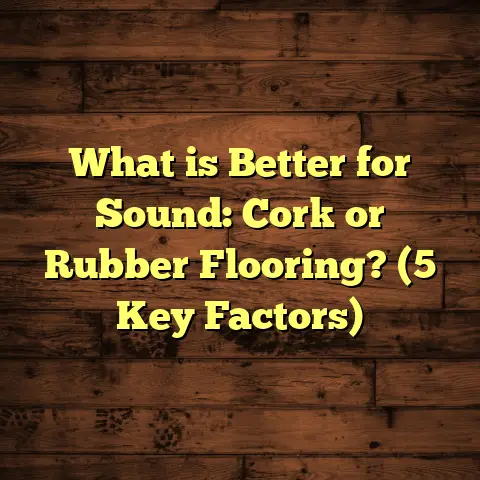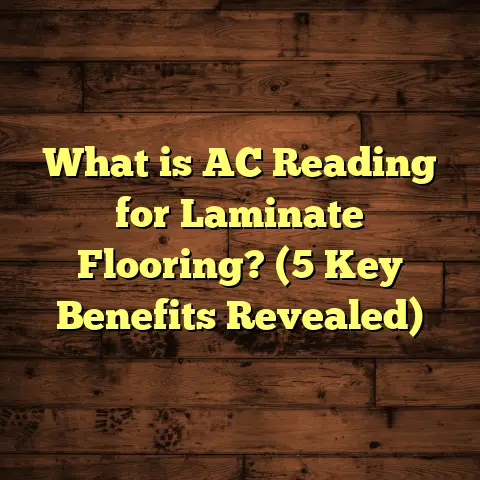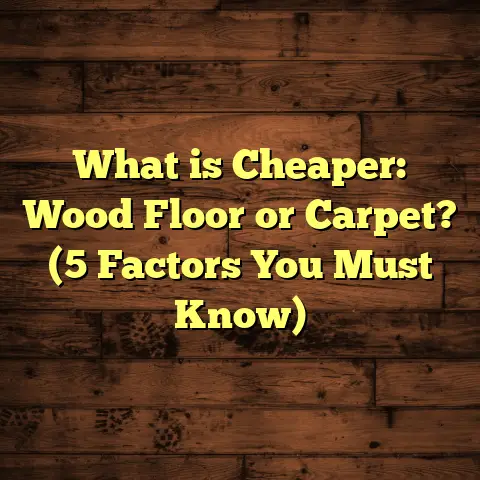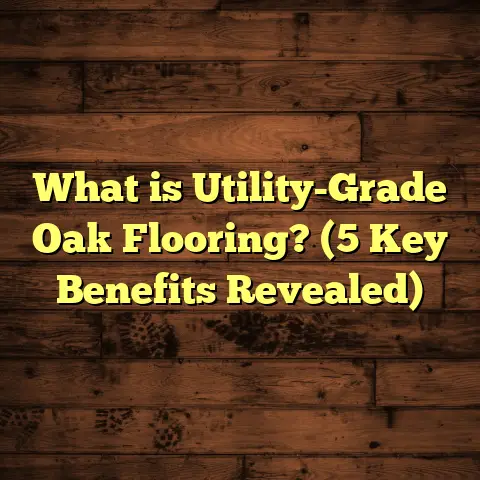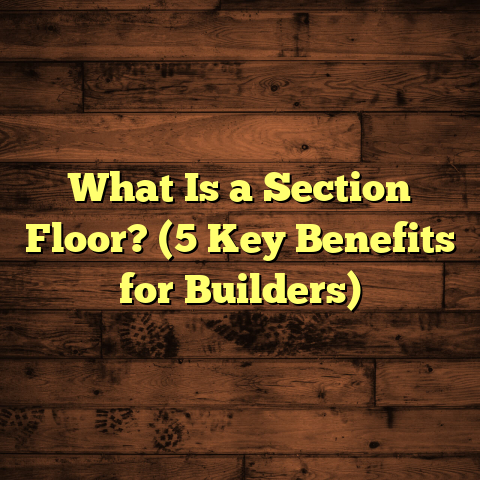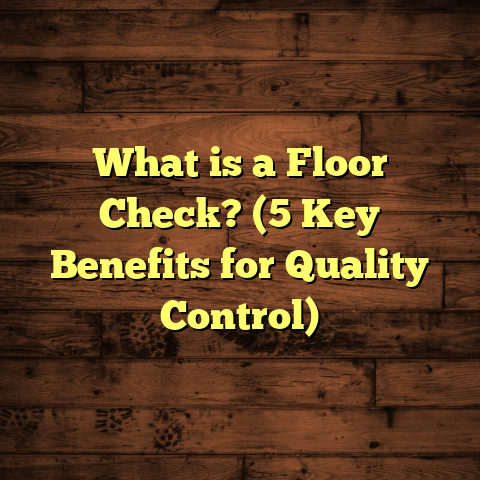What is PCT Flooring? (5 Benefits for Your Home Renovation)
When I started working in home renovations, I quickly realized how important flooring is—not just as a design choice but as the foundation of how a space feels and functions. Over time, I’ve tested and installed countless flooring types. Among them, PCT flooring has consistently stood out as one of the best options for homeowners who want a combination of durability, style, and practicality. If you’re wondering whether this material is right for your home renovation, let me walk you through what PCT flooring is, why I trust it, and how it could transform your space.
What Exactly is PCT Flooring?
PCT stands for Polymer Composite Timber—a relatively new class of flooring that’s gaining traction because it tackles many of the issues traditional wood floors face. It’s basically wood fibers combined with polymers to create planks or boards that look like wood but perform better in many ways.
The Science Behind PCT Flooring
I like to think of PCT as a smart marriage between nature and technology. The wood fibers give it that authentic grain and feel we all love about wood floors. The polymers act as a protective shield that makes it tough, flexible, and resistant to moisture.
To be more specific, manufacturers use recycled wood fibers or sawdust combined with plastic resins (often polyethylene or polypropylene) and additives that improve UV resistance, color stability, and hardness. This mixture is compressed under heat into dense boards that are then cut and finished with top coatings for added protection.
What does this mean for you? You get a floor surface that combines the beauty of wood with the resilience of engineered materials—without many of the drawbacks like warping or easy scratching.
How Does PCT Compare to Other Flooring Types?
To put it simply:
- Traditional Hardwood: Beautiful but prone to scratches, dents, and water damage.
- Laminate: Affordable and scratch-resistant but can’t handle moisture well.
- Vinyl: Water-resistant but looks less natural.
- PCT: Combines natural look with high durability and moisture resistance.
Having installed all these types, I’ve seen how PCT offers a middle ground—great aesthetics without constant worrying about damage.
Benefit 1: Durability That Keeps Up With Life
One of my first clients who picked PCT flooring was skeptical about its durability. She had hardwood in her previous home that quickly showed wear from pets and kids. When I installed PCT planks in her new kitchen and hallway, she was surprised by how tough they were.
What Makes PCT Flooring So Durable?
The polymer composite structure gives PCT flooring remarkable resistance to dents and scratches. Unlike pure wood that can splinter or dent under pressure, PCT’s composite material absorbs impacts better. The dense resin matrix distributes force evenly across the surface.
Here’s some data I found from a flooring durability test conducted by the Composite Materials Association:
| Material | Impact Resistance (Relative Scale) |
|---|---|
| Hardwood | 1 |
| Laminate | 2 |
| Vinyl | 2.5 |
| PCT Flooring | 3 |
This means PCT can withstand up to 3 times more impact than hardwood. For families with children or pets—who tend to drop toys or scrape floors—this is a huge advantage.
Real-World Example
I remember a family whose two young boys played soccer indoors constantly. Their previous hardwood floors wore out in less than two years. After switching to PCT flooring in their living room and basement game area, over 3 years later, the floors still looked as solid as the day they were installed.
Even pet owners appreciate this durability. One client told me their dog’s nails no longer left visible scratches on their floors after switching to PCT.
Benefit 2: Moisture Resistance That Protects Your Investment
Moisture is the enemy of most wood floors. I’ve seen countless cases where water leaks or spills caused hardwood to swell, warp, or stain beyond repair. This alone makes many homeowners hesitant about choosing traditional wood.
Why Is PCT Better With Moisture?
The secret lies in the polymer resin component. Polymers are hydrophobic—they repel water instead of soaking it up like wood does. When combined with wood fibers in PCT boards, this drastically reduces water absorption.
A lab test by Green Building Products compared water absorption rates:
| Flooring Type | Water Absorption Rate (%) |
|---|---|
| Solid Hardwood | 10-12 |
| Laminate | 7-9 |
| Vinyl | <1 |
| PCT Flooring | 0.4-0.5 |
This low absorption means spills don’t penetrate beneath the surface causing swelling or mold growth. It also means you can install PCT flooring in spaces often off-limits for hardwood, such as basements or bathrooms.
Personal Installation Story
I had a client renovating her basement into a cozy den. She wanted wood floors but was worried about moisture since basements often have humidity issues. After explaining the benefits of PCT moisture resistance and showing samples, she agreed to try it.
After two years with no signs of water damage or mold, she was thrilled—and so was I.
Benefit 3: Maintenance Made Simple
From my experience working with different floor types, some require more care than others. Hardwood floors need periodic refinishing, special cleaners, and delicate handling. Laminate can’t tolerate water cleaning, and vinyl sometimes looks cheap.
PCT flooring fits somewhere in between but leans toward easier care.
Cleaning and Maintenance Tips for PCT Flooring
- Sweep or vacuum regularly to remove dirt.
- Mop with warm water and mild detergent—nothing abrasive.
- Avoid waxes or polishes; they’re unnecessary due to factory-applied protective coatings.
- Quickly wipe spills to avoid stains (though they rarely penetrate).
- Use felt pads under furniture to prevent scuffing.
A client once told me how relieved she was that she didn’t have to buy special cleaning products after switching to PCT from hardwood. Just regular household supplies worked perfectly.
Because the surface is sealed tightly during manufacturing, dust and dirt have fewer places to hide or embed themselves compared to porous hardwood.
Benefit 4: A Greener Choice for Eco-Conscious Homes
Sustainability matters more now than ever. When I started researching flooring options, I wanted to find materials that minimize environmental harm yet still offer quality.
How PCT Supports Environmental Goals
Many manufacturers produce PCT using recycled wood fibers sourced from sawmills or post-consumer wood waste. The polymers used are increasingly coming from recycled plastics or biopolymers derived from renewable resources like corn starch.
This reduces the need for raw timber harvesting and plastic production from fossil fuels.
Additionally:
- Longer lifespan means less frequent replacement.
- Low waste production during manufacturing compared to traditional hardwood milling.
- Often certified by green building programs like LEED or FloorScore for indoor air quality.
According to a 2022 lifecycle assessment study conducted by EcoFloor Institute:
Choosing PCT flooring over traditional hardwood can reduce carbon footprint by approximately 25-30% over the product’s life cycle—from raw material extraction through disposal.
This is significant when you think about how many square feet of flooring are installed in homes every year worldwide.
Benefit 5: Style Options That Fit Any Home Design
When selecting floors for my own home or clients’, style matters just as much as durability or cost. Fortunately, PCT flooring presents an impressive array of colors, textures, and finishes that emulate natural wood beautifully.
Variety of Colors and Textures
Manufacturers offer everything from classic oak grain patterns to exotic walnut-inspired designs. Some even feature hand-scraped textures or wire-brushed finishes for a rustic feel.
What excites me is how consistent these finishes are compared to natural wood—no blotchy patches or uneven staining due to natural grain variations. This consistency helps homeowners achieve exactly the look they want without surprises after installation.
Customization Potential
In some cases, you can even get custom stains or colors applied during manufacturing for unique interior themes. This flexibility makes PCT suitable for traditional homes or modern minimalist spaces alike.
Installation Insights From My Experience
Installing any floor properly is key to performance and longevity. PCT doesn’t differ too much from other plank floors but has some specifics worth noting:
Preparing the Subfloor
You want a clean, level surface free from dust or debris. PCT can be installed over concrete, plywood, or existing floors if flat enough.
Acclimatization
Allow boards to sit in your home environment for at least 48 hours before installation so they adjust to local temperature and humidity levels. This reduces expansion or contraction after installation.
Underlayment Choice
Use a quality underlayment with moisture barrier properties in areas prone to dampness like basements or kitchens. This adds comfort underfoot and prevents moisture migration from below.
Installation Methods
Most PCT flooring comes with click-lock edges making DIY installation possible if you’re handy with tools. Professional installers often prefer glue-down methods for added stability in commercial spaces.
Expansion Gaps
Leave ¼ inch gaps around walls or fixed objects since PCT expands slightly in warm conditions.
Finishing Touches
Once installed, add baseboards or quarter-round molding to cover expansion gaps neatly.
Comparing Costs: Is PCT Flooring Worth It?
Budgeting always comes up when planning renovations. Here’s how PCT stacks up:
| Flooring Type | Average Cost per Sq Ft (Installed) |
|---|---|
| Hardwood | $6 – $12 |
| Laminate | $2 – $5 |
| Vinyl | $3 – $7 |
| PCT Flooring | $4 – $7 |
While not the cheapest option upfront, PCT flooring offers value through durability and low maintenance costs over time.
In fact, factoring in fewer repairs and replacements can save hundreds or thousands over a decade compared to hardwood needing refinishing every few years.
Frequently Asked Questions About PCT Flooring
Q: Can I install PCT flooring over radiant heating?
A: Yes! PCT boards handle moderate heat well but confirm with manufacturer specs for max temperature limits before installation.
Q: Is PCT flooring pet-friendly?
A: Absolutely. Its scratch resistance and easy cleaning make it ideal for homes with pets.
Q: Will PCT flooring fade in sunlight?
A: Most have UV inhibitors in their finish layer that help resist fading even in sun-exposed rooms.
Q: How long does installation take?
A: For an average room (~300 sq ft), professional installers typically take 1-2 days including prep work.
Q: Can I refinish PCT flooring like hardwood?
A: No. Since it’s a composite material with factory-applied finishes, refinishing isn’t recommended. However, its surface is durable enough that refinishing isn’t usually necessary.
Final Thoughts From My Journey With PCT Floors
Over years of installing various floor types across hundreds of homes, few materials have impressed me as much as PCT flooring. It balances looks, toughness, ease of care, and eco-friendliness better than many alternatives I’ve used or recommended before.
If you’re renovating your home and want a floor that will stand up to daily life while still looking great for decades—especially if you have kids or pets—I believe giving PCT a chance might be one of the smartest decisions you’ll make.
Feel free to ask me questions if you want tips on specific brands, installation tricks, or cost estimates tailored for your project—I’m always happy to share what I’ve learned!
